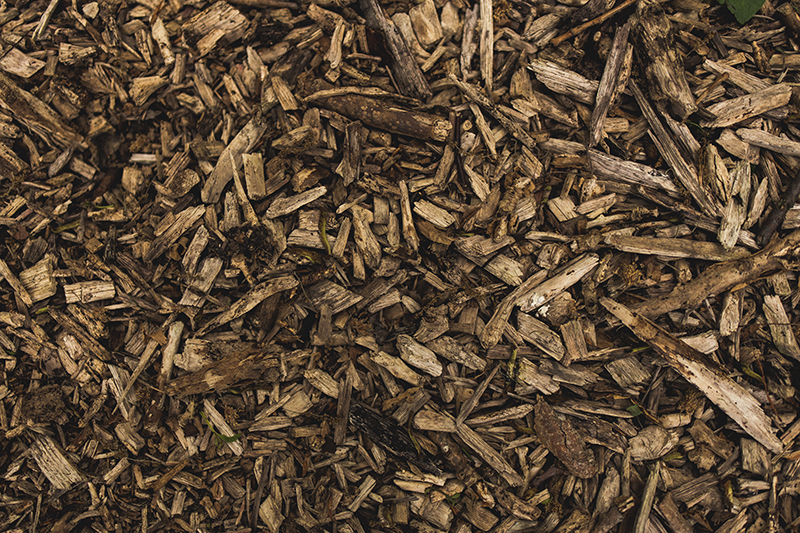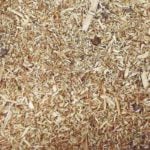On average, mulch costs $192 to $402 per cubic yard to be professionally installed. These prices include delivery and labor (spreading and basic site preparation).
Most homeowners will get a 2- to 3-inch layer of mulch for their landscapes. A cubic yard of mulch covers 162 square feet at 2 inches and 108 square feet at 3 inches. Covering a 500-square-foot area will cost you $593 to $1,241 for a 2-inch layer of mulch and $889 to $1,861 for a 3-inch layer of mulch.
We’ve based these costs on mulch installation prices across the U.S. The cost of your mulch project can change based on the type of mulch and delivery prices.
Cost by Mulch Type

The most important factor in the cost of mulch installation is the type of mulch you’ll use. Here’s a summary of the prices of different mulch types per cubic yard:
If you don’t know what type of mulch you want to use yet, these articles might give you some ideas:
Cost by Location
The cost of mulch and mulch installation changes from area to area because of different costs of living, labor rates, and delivery fees.
The table below lists the average costs of mulch installation across the country, in both bigger cities and smaller ones. These prices are for wood-based mulches, the most common type of mulch.
| Northeast U.S. | Cost per cubic yard of mulch (including labor cost + delivery + materials) |
| New York, NY | $273 – $502 |
| Pawtucket, RI | $188 – $393 |
| Southeast U.S. | |
| Atlanta, GA | $191 – $392 |
| Dothan, AL | $170 – $348 |
| Midwest U.S. | |
| Chicago, IL | $203 – $428 |
| South Bend, IN | $184 – $389 |
| Northwest U.S. | |
| Seattle, WA | $197 – $415 |
| Corvallis OR | $180 – $377 |
| Southwest U.S. | |
| San Diego, CA | $194 – $408 |
| Roswell, NM | $177 – $366 |
Given these variations, it’s a wise idea to look up mulch prices near you to get a more accurate estimate for your specific location.
A free estimate from a local landscaping pro is only a few clicks away on LawnStarter.
Professional Installation Cost vs. DIY Cost
If you already own the necessary equipment for mulch installation, applying the mulch yourself can often be the more affordable option. You’ll still need to pay for the mulch, but you can avoid the mulching service cost.
You can save as much as $20 to $45 per cubic yard of mulch on labor fees. If you pick up the mulch yourself, you can save an additional $70 to $140 on delivery fees.
Check out these articles to learn more about DIY mulching:
- Cost to Install Mulch DIY
- How to Install Mulch DIY
Cost of Bagged Mulch vs. Bulk Mulch
The cost of a bag of mulch ranges from $3.25 to $6.50 per bag. Compare that to how mulch in bulk costs $34 to $185 per cubic yard.
If you want to save more on your mulch, opt for buying mulch in bulk (by the yard or truckload) instead of per bag if you have a big project. A bag of mulch only has 2 cubic feet worth of mulch, and you’ll need 13.5 bags of mulch to get a cubic yard of mulch. Buying a cubic yard’s worth of bagged mulch can cost 35% more than buying a yard of mulch in bulk.
When you buy a bulk truckload of mulch, the cost of each cubic yard begins to lower. You can get a 15% to 30% discount by buying more cubic yards of mulch at a time.
Cost of Delivery
Most mulch suppliers charge a flat mulch delivery cost to bring the product to your home. If your home is far from the supplier, you may be charged even more. On average, mulch delivery fees run from $70 to $140.
The cost of delivery covers more than 1 cubic yard of mulch. A standard pickup truck can carry about 2 to 3 cubic yards of mulch, depending on the type.
Cost of Mulching Sheets
Also called landscape fabric, mulching sheets provide an extra layer of protection against weeds. There are different types of landscape fabric: woven, non-woven, spun, and perforated. They’re also made of different materials, like plastic, fabric, and metal. Landscape fabric can cost as little as $0.05 per square foot to as much as $0.85 per square foot.
Cost of Mulch Removal
We recommend removing your old mulch before adding new mulch to your landscape. Old mulch can look faded and be less effective than new mulch. If your pro’s quote doesn’t include the cost of removing old mulch, then expect to pay $50 to $75 per hour and about $50 to $100 in disposal fees.
Don’t know if your mulch needs replacing? Learn when you should replace your mulch in this article: How Often Should You Replace Mulch?
FAQ
How Much Mulch Do I Need?
Determining how much mulch you need takes a few simple calculations. Grab a pen, paper, calculator, and your thinking cap:
- Step 1: Calculate the square footage of the area you want to mulch.
If the area is a rectangle, multiply its width by its height.
W x H = square footage of the rectangular area
If the area is a circle, measure the distance from its center to its edge. This measurement is called the radius (R). Multiply R by itself, and then multiply the total by 3.14 (π).
R x R x 3.14 = square footage of the circle area
If your garden area is an odd shape, you’ll need to use your imagination. Try to picture the circles and rectangles that make up the area’s unusual shape. Calculate each imaginary shape’s square footage and then add them together to find the total square footage. - Step 2: Decide how deep you want the mulch.
An ideal mulch layer is 2 to 3 inches thick. Decide how deep you want your mulch layer to be, and write that number down. You’ll need it for the next step.
If you’re not sure how deep you should mulch, check out our article about the proper mulch depth here: How Deep Should Mulch Be?
- Step 3: Determine how many cubic yards you need.
Multiply the total square footage of your garden bed by your chosen depth. Your calculation should look like this:
Total square footage of the garden bed x desired depth (inches) = X
Next, divide the above total (X) by 324 (1 cubic yard covers a 324 square-foot area with a 1-inch layer of mulch). This answer will equal the amount of mulch you need in cubic yards.
X / 324 = number of cubic yards you need
If you plan to buy mulch by the truckload, you have all the information you need to make your bulk order. If you plan to buy bags of mulch instead, move onto the next step to find how many bags you need. - Step 4: If you want to buy bagged mulch
One cubic yard equals 27 cubic feet. One mulch bag typically contains 2 cubic feet of mulch. That means 13.5 bags of mulch equals one cubic yard (assuming all the bags hold 2 cubic feet).
To calculate how many bags of mulch you’ll need, follow this simple calculation:
13.5 (bags) x number of cubic yards you need = total bags of mulch
But what if the bags at your local home improvement store don’t sell mulch bags holding 2 cubic feet? There’s a simple solution. Most bags have 2 cubic feet of mulch, but there are exceptions.
Here’s a formula that can help in a case like this:
27 cubic feet / number of cubic feet in the bags = number of bags for 1 cubic yard
Next, multiply the number of bags for 1 cubic yard by the number of cubic yards you need (this number is from Step 3)
Number of bags for 1 cubic yard x number of cubic yards you need = total bags of mulch you need
Where Can I Get Free Mulch?
You can get free mulch in many different places:
- Your local tree care service. They often produce wood chip mulch from pruned and chopped-down trees.
- Your local city or municipal free mulch program. Many cities offer free mulch that you simply have to pick up.
- Your home. You may find these mulch materials around your home:
- Grass clippings (Make sure they’re not chemically treated.)
- Fallen leaves
- Pine needles
- Compost
- Newspaper (Use as sheet mulching.)
- Straw (if you live on or near a farm)
Is Mulch Worth It?
Yes, mulching is worth doing. In fact, it’s one of the easiest but most effective ways to increase your property value.
Mulch has many benefits aside from aesthetics. Learn more about how mulch can benefit your yard and increase your home value in these articles:
Where to Hire a Pro to Mulch Your Landscape
Whether you install the mulch yourself or hire a professional, mulch can be a great addition to your landscape. If you have the supplies and the time, applying the mulch yourself can save you on installation costs.
If you have a large area to cover, hiring a local landscape professional near you may be the way to go.
Note: LawnStarter may get a referral fee for matching you with contractors in your area.
Main Image Credit: Pixabay



![10 Best Mulching Lawn Mowers of 2021 [Reviews]](https://www.lawnstarter.com/blog/wp-content/uploads/2021/01/Best-Mulching-Lawn-Mowers-150x150.jpg)

